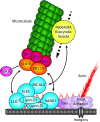Linking cortical microtubule attachment and exocytosis
- PMID: 28491287
- PMCID: PMC5399970
- DOI: 10.12688/f1000research.10729.1
Linking cortical microtubule attachment and exocytosis
Abstract
Exocytosis is a fundamental cellular process whereby secreted molecules are packaged into vesicles that move along cytoskeletal filaments and fuse with the plasma membrane. To function optimally, cells are strongly dependent on precisely controlled delivery of exocytotic cargo. In mammalian cells, microtubules serve as major tracks for vesicle transport by motor proteins, and thus microtubule organization is important for targeted delivery of secretory carriers. Over the years, multiple microtubule-associated and cortical proteins have been discovered that facilitate the interaction between the microtubule plus ends and the cell cortex. In this review, we focus on mammalian protein complexes that have been shown to participate in both cortical microtubule capture and exocytosis, thereby regulating the spatial organization of secretion. These complexes include microtubule plus-end tracking proteins, scaffolding factors, actin-binding proteins, and components of vesicle docking machinery, which together allow efficient coordination of cargo transport and release.
Keywords: IQGAP1; cargo transport; cytoskeleton; exocytosis; mictrotubules; tracking proteins.
Conflict of interest statement
Competing interests: The authors declare that they have no competing interests.No competing interests were disclosed.No competing interests were disclosed.No competing interests were disclosed.
Figures


References
Publication types
LinkOut - more resources
Full Text Sources
Other Literature Sources
Miscellaneous

